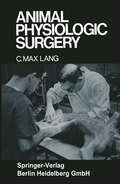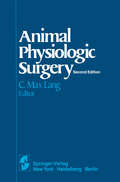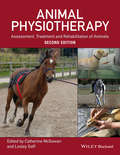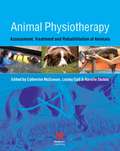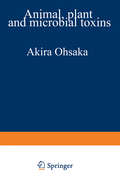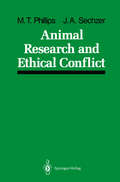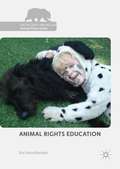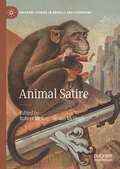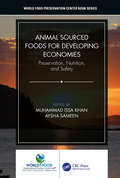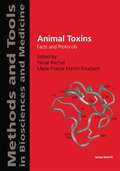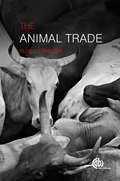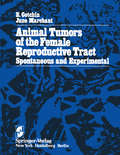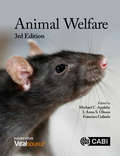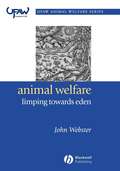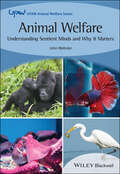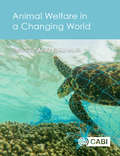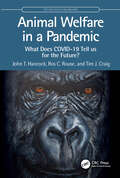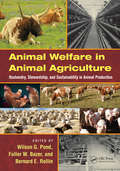- Table View
- List View
Animal Physiologic Surgery
by Carol Max LangAnimal Physiologic Surgery presents an integrated approach to the study of surgery for first-year medical students and graduate students in physiology. The primary emphasis is on the interrela tionships between surgical techniques and physiologic phenomena observed before, during, and after surgery. All procedures described in the book are designed so that the student with a limited knowledge of surgery can successfully assume responsibility for pre- and postoperative care, as well as for the operation. Therefore, the attitude reflected in this work shows the student his obligation, and his privilege, to find the best method of treatment for the patient and to work at his highest capacity. The text begins with an introduction to operating-room proce dures, sutures and instruments, wound healing, anesthesia, and water and electrolyte balance. The second part deals with step-by step surgical instructions and clinical consideration in techniques, such as laparotomy, splenectomy, nephrectomy, and laminectomy. This part is followed by a section on laboratory techniques neces sary for following and evaluating the course of the patient and on postmortem techniques. The text strikes a balance between exacting detail and discussion of basic principles; it is easily adaptable to any curriculum. I am grateful to the contributors for their close cooperation, especially Dr. William J. White for sharing much of the responsi bilities. I am also very appreciative to Catherine Jackson and Anne Kupstas for their valuable editorial assistance, and to Joyce Greene vii Preface and Becky Robertson for their assistance in preparing the manu script.
Animal Physiologic Surgery
by Carol Max LangThis second edition of Animal Physiologic Surgery presents an integrated introduction to surgery for students in all of the health sciences. As with the first, this edition introduces the novice to surgery using the animal model, and emphasizes the relation of surgery to physiologic function. The book begins with a practical introduction to sterile technique and instrumentation, then develops the student's familiarity with basic surgical skills, and progresses to procedures requiring some proficiency and inter pretation. While all of the procedures involve a degree of complexity, our experience has shown that beginning students are capable of handling these exercises as we have presented them. We have expanded and revised the section covering surgical technique in response to the many useful and encouraging comments we received on the first edition. In addition, the section on clinical procedures and laboratory techniques has been reorgan ized to include a chapter on emergency and resuscitative procedures. By emphasizing the physiologic responses to disease states and to surgical intervention, we not only convey an understanding of surgery's potential and limitations, but also point out the student's responsibility for providing the best possible pre-, intra-, and postoperative care. The section on laboratory procedures is designed to provide further insight into the body's physiology in a clinical context. I am grateful to the contributors for their close cooperation, especially Dr.
Animal Physiotherapy: Assessment, Treatment and Rehabilitation of Animals
by Catherine McGowan Lesley GoffA thoroughly updated edition of this essential reference guide for physiotherapists and physical therapists, looking to apply the proven benefits of physiotherapy to the treatment of companion and performance animals. Seven new chapters provide greatly expanded coverage of practical treatment and rehabilitation Includes reviews of different physiotherapy techniques, drawing on both human and animal literature Discusses approaches in small animal medicine as well as for elite equine athletes Provides applied evidence-based clinical reasoning model, with case examples Now in full colour with many more illustrations
Animal Physiotherapy: Assessment, Treatment and Rehabilitation of Animals
by Catherine McGowan Lesley Goff Narelle StubbsAnimal Physiotherapy is an essential reference guide for physiotherapists looking to apply the proven benefits of physiotherapy to the treatment of companion and performance animals. Animal Physiotherapy is a growing profession of physiotherapists who have broadened their expertise from the well-established human sphere to animals. The positive perception of physiotherapy in the human sphere, together with an increased awareness of options and expertise available for animals has resulted in a strong demand for physiotherapy for animals. For the physiotherapist this book provides essential applied background information on animal behaviour, nutrition, biomechanics and exercise physiology. For veterinarians and others who work with animals, the book reviews the scientific principles behind the practice of physiotherapy, and what it can achieve. Includes reviews of different physiotherapy techniques, drawing on both human and animal literature; Discusses approaches in small animal medicine as well as for elite equine athletes; Includes applied evidence-based clinical reasoning model, providing case examples
Animal Physiotherapy: Assessment, Treatment and Rehabilitation of Animals
by Catherine M. McGowan Lesley GoffA thoroughly updated edition of this essential reference guide for physiotherapists and physical therapists, looking to apply the proven benefits of physiotherapy to the treatment of companion and performance animals. Seven new chapters provide greatly expanded coverage of practical treatment and rehabilitation Includes reviews of different physiotherapy techniques, drawing on both human and animal literature Discusses approaches in small animal medicine as well as for elite equine athletes Provides applied evidence-based clinical reasoning model, with case examples Now in full colour with many more illustrations
Animal Physiotherapy: Assessment, Treatment and Rehabilitation of Animals
by Catherine M. McGowan Lesley Goff Narelle StubbsAnimal Physiotherapy is an essential reference guide for physiotherapists looking to apply the proven benefits of physiotherapy to the treatment of companion and performance animals. Animal Physiotherapy is a growing profession of physiotherapists who have broadened their expertise from the well-established human sphere to animals. The positive perception of physiotherapy in the human sphere, together with an increased awareness of options and expertise available for animals has resulted in a strong demand for physiotherapy for animals. For the physiotherapist this book provides essential applied background information on animal behaviour, nutrition, biomechanics and exercise physiology. For veterinarians and others who work with animals, the book reviews the scientific principles behind the practice of physiotherapy, and what it can achieve. Includes reviews of different physiotherapy techniques, drawing on both human and animal literature; Discusses approaches in small animal medicine as well as for elite equine athletes; Includes applied evidence-based clinical reasoning model, providing case examples
Animal, Plant, and Microbial Toxins: Volume 2 Chemistry, Pharmacology, and Immunology
by Akira Ohsaka Kyozo Hayashi Yoshio Sawai Ryosuke Murata Masaru Funatsu Nobuo TamiyaDuring the past two decades, research on animal, plant, and microbial toxins has expanded rapidly, and new and exciting information has appeared to clarify both the clinical and therapeutic aspects of intoxication and, even more impor tant, to help us understand more exactly the structure and the mode of action of toxins on a molecular basis. Because of the interdisciplinary nature of toxin research, it is of vital impor tance that workers specializing in its different aspects should make a particular effort to exchange and keep up with new developments in this rapidly-expanding field. This has been one of the main purposes of the series of international meetings that have been held over the past ten years. The increasing interest in the results of toxin research can be explained partly by the growing general preoccupation with pollution and its toxic effects, which means that more anq more specialists in other fields are finding it necessary to keep in touch with current research into naturally occurring toxins. The papers in these volumes were presented at the Fourth International Symposium on Animal, Plant and Microbial Toxins, organized by the Inter national Society on Toxicology, held in Tokyo in September, 1974. The editors have decided to include both original reports and review articles, arranged according to disciplines. Editing has been kept to the minimum necessary for adequate comprehension of the materials.
Animal Research and Ethical Conflict: An Analysis of the Scientific Literature: 1966–1986
by Mary T. Phillips Jeri A. SechzerThis volume grew out of a project to conduct a survey of the scientific literature of the United States for items addressing the e. thical and humane issues of animal experimentation. The original purpose of the survey was to provide packground information for the development of a set of guide lines for the use of animals in research then in preparation by The New York Academy of Sciences' Ad Hoc Committee on Animal Research. ! We soon realized, however, that the survey constituted a valuable resource in its own right. In this book we present the results of the literature survey along with relevant information about its legislative and historical con text. We hope that this material will be helpful to biomedical researchers grappling with animal welfare problems as well as to social scientists interested in tracing the evolution of the 20th-century phase of the animal research controversy. The time span covered by the survey was selected to match the 20-year period between the passage of the first federal Animal Welfare Act in 1966 and the most recent legislation regulating animal research, which took effect during 1986. Our analysis examines this transitional period through the pages of the scientific literature. During these 2 decades, animal re search in the United States was transformed. Activist animal protection organizations catapulted troublesome ethical questions to national prom inence, throwing the scientific community2 into turmoil.
Animal Restraint for Veterinary Professionals - E-Book
by C. C. Sheldon Teresa F. Sonsthagen James TopelLearn effective animal handling and restraint techniques! Animal Restraint for Veterinary Professionals, 2nd Edition describes each procedure with two to eight photos showing the exact steps needed to achieve safe restraint. A chapter is devoted to each domestic animal species, including cats, dogs, cattle, horses, sheep, goats, pigs, rabbits, rodents, ferrets, and birds. New to this edition are updated photographs showing the latest and greatest restraint procedures for all types of animals. Written by expert veterinary technician educators C.C. Sheldon, Teresa Sonsthagen, and James Topel, this practical guide also includes a chapter on knot tying!Step-by-step guidelines make it easy to understand safe, proper restraint procedures.Over 500 full-color photographs illustrate restraint procedures.A clear, non-technical writing style along with descriptive photographs simplifies animal restraint concepts.Comprehensive coverage in each chapter includes normal and abnormal behavior characteristics, precautions, special handling, restraint devices, and descriptions of medical procedures — such as venipuncture — for which special restraint procedures are necessary.Restraint Principles chapter summarizes the considerations for restraint, animal safety, circumstances for restraint, the effect of restraint on animals, and complications. Knot Tying chapter presents basic types of knots that may be used to safely restrain larger animals. UPDATED chapters include behavioral observations describing what to look for in the animal being restrained.NEW full-color photographs accompany new restraint procedures for various species.NEW! Alternative restraint techniques are added, accompanied by step-by-step photos.
Animal Restraint for Veterinary Professionals - E-Book: Animal Restraint for Veterinary Professionals - E-Book
by C. C. Sheldon James Topel**Selected for Doody's Core Titles® 2024 in Veterinary Nursing & Technology** Master proven techniques for the handling and restraint of common animals! Providing clear guidelines to each procedure, Animal Restraint for Veterinary Professionals, 3rd Edition includes photos showing the exact steps needed to achieve safe restraint of animals seen in the veterinary clinic and visited on farm calls. Separate chapters are devoted to each domestic animal species, including cats, dogs, cattle, horses, sheep, goats, pigs, rabbits, rodents, ferrets, and birds. This edition adds descriptions of new restraint techniques for cats, dogs, and other species. Written by expert veterinary technician instructors C.C. Sheldon, and James A. Topel, this practical guide also includes a chapter on knot tying! - Step-by-step guidelines make it easy to understand safe, commonly used restraint procedures, and include alternative restraint techniques for several different species. - More than 500 full-color images and a clear, non-technical writing style depict and simplify animal restraint concepts. - Comprehensive coverage includes normal and abnormal animal behavior characteristics, precautions, special handling, restraint devices, and descriptions of special restraint techniques for medical procedures such as venipuncture. - Restraint Principles chapter summarizes the considerations for proper restraint, animal safety, circumstances for restraint, the effect of restraint on animals, and complications. - Knot Tying chapter presents basic types of knots that may be used to safely restrain larger animals. - NEW! Additional restraint techniques are included for several species. - NEW! Restraint of Cats chapter is updated to include guidelines and photos for the removal of cats from a carrier, examination in a carrier, and examination in a towel on the handler's lap. - NEW! Restraint of Dogs chapter is updated to include canine head control using a towel, along with safe techniques for administering intramuscular injections to aggressive dogs including the use of a door as a squeeze area and hip catch. - NEW! Learning objectives, chapter outlines, and key terms are added to the beginning of each chapter.
Animal Rights Education (The Palgrave Macmillan Animal Ethics Series)
by Kai HorsthemkeThis book explores how the ethical treatment and status of other-than-human animals influence pedagogy, teaching, and learning in general, aiming to fill what has been a gap in the philosophy of education. It examines key trends in this regard, including environmental education, humane education, posthumanist education, ecopedagogy, critical animal pedagogy, critical animal studies, animal standpoint theory, and vegan education. The book discusses animal minds and interests, and how animals have been accommodated in moral theory. Further, it investigates whether anti-racist and anti-sexist education logically entail anti-speciesist education and closes by proposing animal rights education as a viable and sound alternative, a pedagogy that does justice not only to animals in general and as species, but also to individual animals. If animal rights education is philosophically and educationally meaningful, then it can arguably offer a powerful pedagogical tool, and facilitate lasting pro-animal changes.
Animal Satire (Palgrave Studies in Animals and Literature)
by Robert McKay Susan McHughAnimal Satire presents a cultural history of animal satire, a critically neglected but persistent presence in the history of cultural production, in which animals expose human folly while the strategies of satire expose the folly of human-animal relations. Highlighting the teeming animal presences across the history of satirical expression from Aristophanes to Twitter, with chapters on key works of literature, drama, film, and a plethora of satirical media, Animal Satire reveals the rich rhetorical significance of animality in powering the politics of satire from ancient and medieval through modern and contemporary times. More pressingly, the book makes the case for the significance of satire for understanding the real-world implications of rhetoric about animals in ongoing struggles for justice. By gathering both critical and creative examples from representative media forms, historical periods, and continents, this volume aims to enrich scholarship on the history of satire as well as empower creative practitioners with ideas about its practical applications today.
Animal Sourced Foods for Developing Economies: Preservation, Nutrition, and Safety (World Food Preservation Center Book Series)
by Muhammad Issa Khan Aysha SameenAnimal products are good source of disposable income for many small farmers in developing countries. In fact, livestock are often the most important cash crop in many small holder mixed farming systems. Livestock ownership currently supports and sustains the livelihoods of rural poor, who depend partially or fully on livestock for their income and/or subsistence. Human population growth, increasing urbanization and rising incomes are predicted to double the demand for, and production of, livestock products in the developing countries over the next twenty years. The future holds great opportunities for animal production in developing countries. Animal Sourced Foods for Developing Economies addresses five major issues: 1) Food safety and nutritional status in developing world; 2) the contribution of animal origin foods in human health; 3) Production processes of animal foods along with their preservation strategies; 4) functional outcomes of animal derived foods; and finally, 5) strategies, issues and polices to promote animal origin food consumption. Animal sourced food contain high biological value protein and important micronutrients required for optimal body functioning but are regarded as sources of fat that contribute to the intake of total and saturated fatty acids in diet. The quality of protein source has a direct influence on protein digestibility, as a greater proportion of higher quality proteins is absorbed and becomes available for bodily functions. Animal foods has high quantity and quality of protein that includes a full complement of the essential amino acids in the right proportion. Land availability limits the expansion of livestock numbers in extensive production systems in most regions, and the bulk of the increase in livestock production will come from increased productivity through intensification and a wider adoption of existing and new production and marketing technologies. The significant changes in the global consumption and demand for animal source foods, along with increasing pressures on resources, are having some important implications for the principal production systems. In this book, contributors critically analyze and describe different aspects of animal’s origin foods. Each chapter is dedicated to a specific type of food from animal source, its nutritional significance, preservation techniques, processed products, safety and quality aspects on conceptual framework. Special attention is given to explain current food safety scenario in developing countries and contribution of animal derived food in their dietary intake. Existing challenges regarding production, processing and promotion of animal’s origin foods are also addressed with possible solutions and strengthening approaches.
Animal Sourced Foods for Developing Economies: Preservation, Nutrition, and Safety (World Food Preservation Center Book Series)
by Muhammad Issa Khan Aysha SameenAnimal products are good source of disposable income for many small farmers in developing countries. In fact, livestock are often the most important cash crop in many small holder mixed farming systems. Livestock ownership currently supports and sustains the livelihoods of rural poor, who depend partially or fully on livestock for their income and/or subsistence. Human population growth, increasing urbanization and rising incomes are predicted to double the demand for, and production of, livestock products in the developing countries over the next twenty years. The future holds great opportunities for animal production in developing countries. Animal Sourced Foods for Developing Economies addresses five major issues: 1) Food safety and nutritional status in developing world; 2) the contribution of animal origin foods in human health; 3) Production processes of animal foods along with their preservation strategies; 4) functional outcomes of animal derived foods; and finally, 5) strategies, issues and polices to promote animal origin food consumption. Animal sourced food contain high biological value protein and important micronutrients required for optimal body functioning but are regarded as sources of fat that contribute to the intake of total and saturated fatty acids in diet. The quality of protein source has a direct influence on protein digestibility, as a greater proportion of higher quality proteins is absorbed and becomes available for bodily functions. Animal foods has high quantity and quality of protein that includes a full complement of the essential amino acids in the right proportion. Land availability limits the expansion of livestock numbers in extensive production systems in most regions, and the bulk of the increase in livestock production will come from increased productivity through intensification and a wider adoption of existing and new production and marketing technologies. The significant changes in the global consumption and demand for animal source foods, along with increasing pressures on resources, are having some important implications for the principal production systems. In this book, contributors critically analyze and describe different aspects of animal’s origin foods. Each chapter is dedicated to a specific type of food from animal source, its nutritional significance, preservation techniques, processed products, safety and quality aspects on conceptual framework. Special attention is given to explain current food safety scenario in developing countries and contribution of animal derived food in their dietary intake. Existing challenges regarding production, processing and promotion of animal’s origin foods are also addressed with possible solutions and strengthening approaches.
Animal Toxins: Facts and Protocols (Methods and Tools in Biosciences and Medicine)
by Herve Rochat Marie-France Martin-EauclaireThis manual surveys toxins from insects, spiders, mollusks, fish, and snakes which have biotechnological applications. It reviews aspects of toxin origin, their molecular mechanism, and their cellular and pathogenic effects. It also provides methodology for the application of these toxins in the research laboratory. This includes a description of the extraction methods, biochemical characterization, and applications in pharmacological studies.
Animal Trade, The: Evolution, Ethics and Implications
by Clive PhillipsTrade is an inevitable part of human activity and evolution, but when it involves animals there are important ethical issues that have to be considered. Animal trade is often for economic reasons only, and may be hard to justify ethically. There are significant welfare and environmental costs to animals and human society that must be carefully evaluated before such a trade is sanctioned. Controversial and thought-provoking, this text focuses on the trade in live and dead animals and animal parts. It examines the facts and figures to quantify the scope of the animal trade, concentrating mainly on farm animals, but also covering captive wildlife and companion animals. The book describes welfare, environmental, economic and cultural issues around this trade, debating important ethical considerations for everyone that uses or is otherwise involved with animals, especially people in animal welfare.
Animal Tumors of the Female Reproductive Tract: Spontaneous and Experimental
by E. Cotchin J. MarchantThe chapters which comprise this book were prepared as part of a medical text, Pathology of the Female Genital Tract, which is intended for the obstetrician, gynecologist, and medical pathologist. In that context, we were con cerned to bring out the importance of the study of tumors of the female reproductive tract of animals, both as show ing the variety of spontaneous neoplasms that might affect the tract and as providing tumors capable of experimental reproduction. These chapters are published separately, since they contain information which may appeal to a range of readers who might not necessarily wish to acquire the full medical text-for example, to veterinary and comparative pathologists, cancer research workers, research workers in gynecology, experimental pathologists and endocrinologists, and possibly to others using animals in experimental and pharmaceutical studies. The survey of spontaneous tumors of the female repro ductive tract is largely concerned with tumors of the ovaries and uterus of domesticated animals, but attention is also given to laboratory animals, wild animals, and animals in zoos. The spontaneous tumors are well worth studying, not only because of their obvious clinical impor tance to veterinarians, but also because they might provide a stimulus for epidemiologic, etiologic, biologic, and ther apeutic investigations that may elucidate some of the problems related to their counterparts in humans.
Animal Welfare
by Michael Appleby Richard Bennett Dominique Blache Alain Boissy Charlotte C. Burn Dr Andrew Butterworth Michael Cockram Grahame Coleman Richard B D’Eath Ian J.H. Duncan Professor Cathy M Dwyer Paul Flecknell David Fraser Francisco Galindo Paul Hemsworth Stella Maris Huertas Barry Hughes Bryan Jones Linda Keeling Joergen B. Kjaer Ute Knierim Ilias Kyriazakis Shane K. Maloney Georgia Mason Joy Mench Professor Michael Mendl Ruth C Newberry Christine Nicol Birte L. Nielsen Anna Olsson Edmond A. Pajor Clare Palmer Jeffrey Rushen Peter Sandøe Sally L. Sherwen Marek Spinka Claudia Terlouw Paul Thompson Bert Tolkamp Ignacio Viñuela-Fernández Natalie K. Waran Daniel M Weary Francoise Wemelsfelder Nadja Wielebnowski Hanno Würbel Paul HockingUpdated and revised, this bestselling textbook continues to provide a broad introduction to the key topics in the welfare of animals both large and small, farm and companion, wild and zoo. It retains all the popular features of the previous editions with coverage of key issues such as ethics, animal pain and injury, health and disease, social conditions, and welfare dilemmas and problems. Importantly, it also offers practical advice for welfare assessment, with a full section dedicated to the implementation of solutions. The third edition: - Contains many more examples of welfare issues in different countries, particularly the implications for smallholders as well as larger scale agriculture - Covers fish welfare as well as welfare of amphibians, reptiles and invertebrates - Includes concepts of positive emotion and other positive aspects of welfare - Focuses on animal welfare and sustainability - Includes an integrated ebook with additional material and videos With contributions from renowned international experts and a new editorial team, Animal Welfare, 3rd Edition is an essential resource for students and researchers in animal and veterinary sciences and other disciplines considering the science and practice of animal welfare, and for practitioners and decision-makers worldwide.
Animal Welfare: A Practical Approach to Redressing the Problem of Our Dominion Over the Animals
by John WebsterThere has been a recent explosion of active concern in matters of animal welfare. The science behind animal welfare has progressed significantly, new codes of practice and legislation have come into to being, and innovative methods to assess welfare schemes for food production have emerged. Part of a major animal welfare series, Animal Welfare: Limping Towards Eden is John Webster’s new and groundbreaking work on animal welfare. Building on his first book, the highly acclaimed Animal Welfare: A Cool Eye Towards Eden, it not only critically reviews areas of development, but looks to how animal welfare can be improved in the future. Special consideration is given to: Defining animal welfare (‘fit and happy’) and establishing a systematic approach for its evaluation (the ‘five freedoms’); Providing a sound ethical framework that affords proper respect to animals within the broader context of our duties as citizens to the welfare of society; Developing comprehensive, robust protocols for assessing animal welfare and the provisions that constitute good husbandry; Introducing an education policy that will increase human awareness of animal welfare problems and promote action to reduce suffering. This book is part of the UFAW/Wiley-Blackwell Animal Welfare Book Series. This major series of books produced in collaboration between UFAW (The Universities Federation for Animal Welfare), and Wiley-Blackwell provides an authoritative source of information on worldwide developments, current thinking and best practice in the field of animal welfare science and technology. For details of all of the titles in the series see www.wiley.com/go/ufaw.
Animal Welfare: Understanding Sentient Minds and Why It Matters (UFAW Animal Welfare)
by John WebsterAnimal Welfare An Accessible Overview of the Concept of Sentience Throughout the Animal Kingdom and Why It Matters to Humans Animal Welfare explores the concept of sentience and the development of sentient minds throughout the animal kingdom. The work provides improved definitions and analysis of the ideas of sentience, cognition, and consciousness, along with evidence of advanced mental formulation in birds, fish, and invertebrates. Considerations between humans and animals are also discussed, such as outcome-based ethics in relation to humans’ duties of care and the rights and wrongs of domestication. The work is divided into three parts and covers key topics such as: Specifics of animal sentience, from pain and suffering, to fear and dread, all the way to animals’ social life and the comfort/joy/hope/despair they experience What we know about the sentience of different classes of animals in the waters, air, savannah/plains, and forests Considerations on human interactions based on animal sentience, including death (killing), animal farms, animals in laboratories, wild animals in captivity, and animals in sports and entertainment Analysis on what humans can learn from animals based on what we know about their varying levels of sentience Animal Welfare serves as an invaluable analysis of animal sentience for students, teachers, and professionals directly involved in the study, teaching, and applications of animal behavior, motivation, and welfare. Thanks to the wide-ranging implications of animal sentience, the work will also appeal to everyone with a broader interest in animal behavior and human/animal interactions.
Animal Welfare: Understanding Sentient Minds and Why It Matters (UFAW Animal Welfare #3)
by John WebsterAnimal Welfare An Accessible Overview of the Concept of Sentience Throughout the Animal Kingdom and Why It Matters to Humans Animal Welfare explores the concept of sentience and the development of sentient minds throughout the animal kingdom. The work provides improved definitions and analysis of the ideas of sentience, cognition, and consciousness, along with evidence of advanced mental formulation in birds, fish, and invertebrates. Considerations between humans and animals are also discussed, such as outcome-based ethics in relation to humans’ duties of care and the rights and wrongs of domestication. The work is divided into three parts and covers key topics such as: Specifics of animal sentience, from pain and suffering, to fear and dread, all the way to animals’ social life and the comfort/joy/hope/despair they experience What we know about the sentience of different classes of animals in the waters, air, savannah/plains, and forests Considerations on human interactions based on animal sentience, including death (killing), animal farms, animals in laboratories, wild animals in captivity, and animals in sports and entertainment Analysis on what humans can learn from animals based on what we know about their varying levels of sentience Animal Welfare serves as an invaluable analysis of animal sentience for students, teachers, and professionals directly involved in the study, teaching, and applications of animal behavior, motivation, and welfare. Thanks to the wide-ranging implications of animal sentience, the work will also appeal to everyone with a broader interest in animal behavior and human/animal interactions.
Animal Welfare in a Changing World
by Rebecca Aldworth Shelley M. Alexander Regina Asmutis-Silvia Panayiotis Panos Azmanis Prof Daniel Berckmans Lotta Berg Harry Blokhuis Xavier Boivin John Bradshaw Prof. Victoria Braithwaite Stijn Bruers Henry Buller Dr Andrew Butterworth Joyce D’Silva Sarah Dolman Chris Draper David Fennell Dr Charles Foster Taryn Glass Temple Grandin Adam Hart Dr Sophia Hepple Kristof Hermans Elly Hiby Dr Miel Hostens Mark Jones Michael J Kuba Philip Lymbery Miriam Martin Tomas Norton Geert Opsomer Maria Panagiotopoulou Paul C. Paquet Conor Ryan Mark Simmonds Kalliopi Stara Rigas Tsiakiris Dr Bonny Ranst Paul Whittington Dr James W YeatesContemporary and challenging, this thought-provoking book outlines a number of the key dilemmas in animal welfare for today's, and tomorrow's, world. The issues discussed range from the welfare of hunted animals, to debates around intensive farming versus sustainability, and the effects of climate and environmental change. The book explores the effects of fences on wild animals and human impacts on carrion animals; the impacts of tourism on animal welfare; philosophical questions about speciesism; and the quality and quantity of animal lives. The welfare impacts of human-animal interactions are explored, including human impacts on marine mammals, fish, wildlife, and companion and farm animals. Animal Welfare in a Changing World provides: Concise, opinion-based views on important issues in animal welfare by world experts and key opinion leaders. Pieces based on experience, which balance evidence-based approaches and the welfare impacts of direct engagement through training, campaigning and education. A wide-ranging collection of examples and descriptions of animal welfare topics which outline dilemmas in the real world, that are sometimes challenging, and not always comfortable reading. This is a 'must-read' book for animal and veterinary scientists, ethologists, policy and opinion leaders, NGOs, conservation biologists and anyone who feels passionately about the welfare of animals
Animal Welfare in a Pandemic: What Does COVID-19 Tell us for the Future? (CRC One Health One Welfare)
by John T. Hancock Ros C. Rouse Tim J. CraigAnimal Welfare in a Pandemic explores the impact of COVID-19 on a wide array of animals, from those in the wild to companion and captive animals. During the height of the pandemic, a range of animals were infected, and many died, but this was hard to predict, even using up-to-date bioinformatics. Lockdowns around the world had, and continue to have, a major effect on animals’ welfare, influencing pet ownership and care, as well as impacting on the work of conservation institutes due to the lack of visitors and funding and lack of tourist presence in the wild which impacted on anti-poaching efforts. Some of the vast amount of personal protection equipment (PPE) that was distributed was discarded, creating both dangers and occasional opportunities for wild animals. With the rollout of human vaccines, some countries started developing animal vaccines, only some of which were deployed. In summary, the pandemic had a wide-ranging influence on animal welfare around the world. This is reviewed to highlight what can be learned to protect and enhance animal welfare in future epidemics/pandemics, and contribute to a genuinely One Health approach where the health and welfare of both humans and animals are considered holistically.This book is authored by members of the University of the West of England, Bristol, who span a range of expertise in Biological Sciences, Social Sciences, Animal Welfare, and Ethics.
Animal Welfare in a Pandemic: What Does COVID-19 Tell us for the Future? (CRC One Health One Welfare)
by John T. Hancock Ros C. Rouse Tim J. CraigAnimal Welfare in a Pandemic explores the impact of COVID-19 on a wide array of animals, from those in the wild to companion and captive animals. During the height of the pandemic, a range of animals were infected, and many died, but this was hard to predict, even using up-to-date bioinformatics. Lockdowns around the world had, and continue to have, a major effect on animals’ welfare, influencing pet ownership and care, as well as impacting on the work of conservation institutes due to the lack of visitors and funding and lack of tourist presence in the wild which impacted on anti-poaching efforts. Some of the vast amount of personal protection equipment (PPE) that was distributed was discarded, creating both dangers and occasional opportunities for wild animals. With the rollout of human vaccines, some countries started developing animal vaccines, only some of which were deployed. In summary, the pandemic had a wide-ranging influence on animal welfare around the world. This is reviewed to highlight what can be learned to protect and enhance animal welfare in future epidemics/pandemics, and contribute to a genuinely One Health approach where the health and welfare of both humans and animals are considered holistically.This book is authored by members of the University of the West of England, Bristol, who span a range of expertise in Biological Sciences, Social Sciences, Animal Welfare, and Ethics.
Animal Welfare in Animal Agriculture: Husbandry, Stewardship, and Sustainability in Animal Production
by Wilson G. Pond Fuller W. Bazer Bernard E. RollinWhat constitutes animal welfare? With animals being used for companionship, service, research, food, fiber, and by-products, animal welfare is a topic of great interest and importance to society. As the world's population continues to increase, a major challenge for society is the maintenance of a strong and viable food system, which is linked to t
